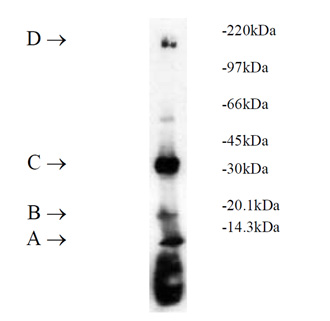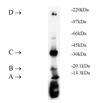Product Details
| MW: | ~22kDa |
| |
| Source: | Produced in E. coli. |
| |
| UniProt ID: | P68036 |
| |
| Formulation: | Liquid. In 50 mM HEPES, pH 7.5, containing 150 mM NaCl and 1 mM DTT. |
| |
| Purity: | ≥95% (SDS-PAGE) |
| |
| Biological Activity: | Recombinant UbcH7 charges and supports ubiquitinylation in vitro. |
| |
| Application Notes: | Typical enzyme concentration to support conjugation in vitro is 100nM to 1µM depending upon conditions. |
| |
| Shipping: | Dry Ice |
| |
| Long Term Storage: | -80°C |
| |
| Use/Stability: | Enzyme is stable to multiple freeze/thaw cycles. |
| |
| Scientific Background: | Ubiquitinylation of proteins constitutes an important cellular mechanism for targeting short-lived proteins for degradation by the 26S proteasome.
Three classes of enzymes are involved in the conjugation of ubiquitin to proteins. E1, the ubiquitin activating enzyme, activates ubiquitin through the ATP-dependent formation of a high-energy thiol ester bond between the carboxyl terminus of ubiquitin and the active-site cysteine within E1. This E1-activated ubiquitin is transferred to a cysteine residue of an E2, or ubiquitin-conjugating enzyme (UbC). E2 enzymes, either by themselves or in conjunction with E3 enzymes (ubiquitin ligases), then transfer ubiquitin to target proteins forming stable isopeptide bonds resulting in multi-ubiquitin chain formation. It is the diverse combinations of E2-E3 complexes which are thought to define substrate specificity.
UbcH7 is a class I enzyme which functions in the stress response and the control of transcription factors1. The enzyme is ubiquitously expressed with high levels of expression seen in adult muscle2. It has been demonstrated to participate in the ubiquitinylation of p53, c-Fos and NF-κB. UbcH7 is one of two E2s (UbcH5 being the other) with which HECT domain proteins interact with UbcH7 being able to efficiently substitute for UbcH5 in E6-AP-dependent ubiquitinylation. |
| |
| Regulatory Status: | RUO - Research Use Only |
| |

BML-UW9080 has been characterized in a thiolester assay using biotinylated ubiquitin as shown opposite. Labels are as follows: A – biotinylated ubiquitin; B – probably biotinylated di-ubiquitin; C – biotinyl-ubiquitin thiol ester linked UbcH7; D – biotinylubiquitin thiol ester linked E1.
Please mouse over
Product Literature References
F-box protein Fbxl18 mediates polyubiquitylation and proteasomal degradation of the pro-apoptotic SCF subunit Fbxl7: Y. Liu, et al.; Cell Death Dis.
6, e1630 (2015),
Application(s): Assay,
Abstract;
Full Text
General Literature References
Parkin ubiquinates the α-synuclein-interacting protein, synphilin-1: Implications for Lewy-body formation in Parkinson disease: KK Chung et al.; Nature Medicine 7, 1144 (2001),
Characterisation of human hect domain family members and their interaction with UbcH5 and UbcH7: S.E. Schwarz et al.; J. Biol. Chem. 273, 12148 (1998),
Fine-mapping, genomic organisation, and transcript analysis of the human ubiquitin-conjugating enzyme gene UBE2L3.: T.P. Moynihan et al.; Genomics 51, 124 (1998),
Cloning of human ubiquitin-conjugating enzymes UbcH6 and UbcH7 (E2-F1) and characterisation of their interaction with E6-AP and RSP5. : U. Nuber, et al.; J. Biol. Chem. 271, 2795 (1996),
The ubiquitin-conjugation system. : Jentsch, S. ; Annu. Rev. Genet. 22, 179-207 (1992),













